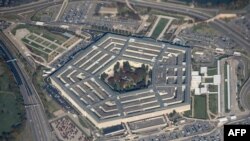U.S. military officials are planning for additional battles against the coronavirus, even after the current pandemic subsides, pointing to evidence that suggests the virus will be cyclical.
For weeks, infectious disease experts have been warning that COVID-19 could resurge in the United States in September and October as the weather begins to cool ahead of the winter months. It is a threat that has resonated with some of the military’s most senior officials.
“We are all talking about it,” U.S. Air Force Chief of Staff, Gen. Dave Goldfein, told defense reporters Wednesday.
"The potential for it to come back in some cyclical way is likely,” he said. "All the projections are no vaccine for upwards of a year, so that means we've got to refine our ability to survive and operate."
Top military officials say despite the rapid spread of the virus, U.S. forces remain ready to defend the nation and its interests. As of Wednesday, more than 56,000 active and part-time troops have been deployed to assist with relief efforts across the country.
But the pandemic has also taken a toll.
Key military exercises with partner forces in Africa, Asia and Europe have been downsized, canceled or postponed.
The U.S. military footprint in places like Iraq and Syria, where U.S. troops are working with local forces against the Islamic State terror group, has been downsized.
And while military commanders note that U.S. troops are generally younger and healthier than the rest of the population, they have not been immune.
To date, more than 3,500 active duty U.S. military personnel have tested positive for COVID-19, according to Pentagon figures. Eighty-five have been hospitalized. Two have died, including a sailor assigned to the USS Theodore Roosevelt, a nuclear-powered aircraft carrier.
When civilian employees, contractors and military dependents, like spouses and children, are included, the number of total coronavirus cases jumps to more than 5,700, with 25 deaths.
Pentagon officials have taken measures to slow the spread, shifting 970,000 active duty and civilian employees to telework, while mandating the use of face masks, requiring physical (social) distancing and cleaning workspaces constantly for those who cannot work from home.
The Air Force has taken additional measures to ensure there is no disruption to critical capabilities, isolating some bomber crews and nuclear missile crews.
“The procedures in place, knock on wood, are working,” Goldfein said, adding that so far, neither group has recorded a positive COVID-19 test.
Still, senior military officials on the Defense Department’s coronavirus task force are not taking such successes for granted.
“It's the job of the military to prepare for worst-case scenarios,” Gen. John Hyten, vice chairman of the Joint Chiefs of Staff, said Wednesday. “We will plan for something worse to happen in the fall.”
Part of that is aimed at making sure the military is ready in case it needs to deal with more conventional threats.
To that end, the Pentagon is planning to ramp up testing, starting with those working on the most critical mission sets, such as nuclear capability and deterrence, followed by forces stationed around the world, and finally, those stationed in the U.S.
Officials said they expect testing for the first group to be completed by the end of the month, though testing all U.S. forces for COVID-19 likely will not be completed until July or August.
The other part is to make sure troops can continue to help at home.
“You will see us continue with fiscal prudence, not wanting to overstate it, to be ready if something happens, there is the capacity to handle it,” said Deputy Defense Secretary David Norquist.
“We need to be prepared to have the masks and the facilities and the beds to be able to mitigate that risk,” he said.








